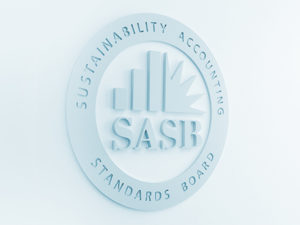
Kelli Okuji Wilson, Analyst, Sector Lead – Health Care, SASB
An interview with Kelli Okuji Wilson. Kelli Okuji Wilson is an Analyst and the Health Care Sector Lead at SASB, and is leading the Human Capital project.
- How does SASB currently address the issues of diversity and inclusion?
SASB Standards address five sustainability dimensions, one of which is human capital. Within the human capital sustainability dimension, there are three categories that highlight the relevant sustainability themes: Employee Health & Safety, Labor Practices, and Employee Engagement, Diversity & Inclusion. Currently, 13 of our 77 industry standards address diversity and inclusion via disclosure topics that address the industry-specific, financially-material impact of this issue.
- In the current standards, why do certain industries include a disclosure topic on diversity and inclusion, while others do not?
First, it is important to note that sustainability issues can be viewed through two lenses: financial materiality (i.e. how the issue impacts a company’s financial performance) and societal/environmental materiality (i.e. how a company’s performance on the issue impacts people and planet). This is a dynamic process, known as dynamic materiality[1]: impacts on the public good can become financially material over time.
SASB’s standard-setting process is laser-focused on financial materiality. As described in our Conceptual Framework[2], topics in our Standards must be substantiated by evidence of financial impact and broad market feedback that the issue is financially material. An issue can be important—and societally and/or environmentally material—but not included in the SASB Standard for a certain industry absent evidence supporting its financial materiality.
The field of diversity and inclusion has continued to advance since the codification of our Standards. As part of our research and consultation activities, we are continually monitoring evidence related to the financial materiality of diversity and inclusion across industries as well as how the issue is currently addressed within our codified Standards. This research and consultation include the evaluation of where the Standards may be further strengthened to include issues that may not be currently addressed and where evidence of the financial materiality of these issues has emerged.
- How are issues of diversity and inclusion being considered in SASB’s human capital project?
During the first stage of the Human Capital project, we performed a literature review to help establish an evidenced-based view on human capital management issues affecting companies broadly and expand our current thinking around the human capital issues that we addressed in our codified standards. Workplace culture was frequently cited as a critical contributor to long-term financial performance. While our codified standards address aspects of workplace culture such as diversity, inclusion, and engagement, our literature review suggested that these concepts could be more broadly applicable to our 77 industry standards and should be considered under the wider conceptual umbrella of workplace culture.
Following our literature review phase, we performed targeted consultations with investors, where we gained important feedback on diversity and inclusion that will ultimately inform our standard-setting on this issue. First, we learned that investors are engaging with companies on workplace culture, and such engagement informs their decision-making processes, particularly in certain industries. Second, we learned that diversity, inclusion, and engagement continue to represent important issues for companies that can be tied to financially material impacts in industry-specific ways. Third, we learned about the usefulness of qualitative disclosure around diversity, inclusion, and culture, in addition to quantitative data. While difficult to quantify, a company’s culture, including its approach to managing diversity and inclusion, can be critical to an innovative and productive business, particularly in some industries. Qualitative disclosure can first help establish that a company recognises the importance of its culture in driving performance, and second identify its specific policies, strategies, or other aspects of stewarding its culture in differentiating it from its competitors.
Based on these preliminary consultations and the results of our upcoming public consultation period, we will evaluate each industry to identify how diversity, inclusion, and engagement issues manifest. We will then evaluate the financial materiality of these issues to ultimately inform potential standard-setting activities.
- What feedback has SASB heard from investors and companies regarding their views and measurement of diversity and inclusion, particularly considering the protests for racial justice?
Preliminary feedback from investors and companies has emphasized that the protests for racial justice has illuminated the social inequalities resulting from systemic racism and are driving the attention necessary to make meaningful change. Investors want to understand what constitutes meaningful corporate action, and what metric—or what “bouquet” of metrics—would be most useful to assess company management of these issues in a decision-useful way. Companies are important actors in managing these issues and providing this information to their investors.
While we are still exploring what are the most effective forms of measurement, our research and consultation to date suggest that it may be helpful for companies to disclose gender and race/ethnic breakdown of employees by job level, employee engagement, and/or promotion rates for example. This example is just one of the many ways that companies could report on this complex issue in a decision-useful way. In our continued research on the topic, we want to understand if and how companies are tracking this information, challenges they face in doing so, and ultimately how such data informs their internal management and decision-making.
One important piece of feedback we received relates to the international applicability of quantitative disclosures around diversity, and particularly when this applies to racial and ethnic diversity. This feedback noted that relevant data on racial and ethnic diversity will vary depending on the region, and additionally there may be limitations to how such data can be collected or reported depending on applicable legal requirements. We are performing further research to understand this issue and would welcome additional feedback as part of our research project.
In addition to the above, our recent consultations with investors and other stakeholders have raised additional aspects of diversity related to how we define the term. These conversations, as well as some very preliminary industry-specific research, have surfaced several important trends that are elucidating the multi-faceted nature of diversity, outside of the scope of gender and racial/ethnic diversity.
For example, we have received feedback noting how diversity can directly impact the experience of individual employees and their relationship with their employer. In addition, we have learned about how diverse workforces can affect a company’s end products or services. The former can create a more inclusive environment and reduce the risk of discrimination and harassment, while the latter can help teams within a company develop products or services that reflect the needs of a diverse consumer base.
Our preliminary industry-specific research has also raised the notion that certain aspects of diversity, such as age or disability, can work in tandem to other diversity issues, such as gender and racial/ethnic diversity, at an industry-specific level. For example, in some manufacturing industries, an ageing workforce has been cited as a relevant and potentially material risk to these industries and where recruiting younger talent is critical. In other industries, investors have coalesced around disability inclusion as part of a company’s diversity efforts as a relevant sustainability issue and, potentially, financially material risk and benefit to companies.
- What is next for SASB’s work on diversity and inclusion?
We are currently in the process of preparing for a public consultation on our human capital management project, including preparing a written summary of our research to date and specific questions for which we are seeking stakeholder feedback. As part of this public consultation, we will seek feedback from companies, investors, and other stakeholders that are well versed in the impacts of this issue at an industry-specific level to provide feedback on (a) what investors find are the most meaningful points of data to assess this issue in a comprehensive way and, if appropriate, on a regional specific basis and (b) how companies are managing and tracking these issues, but also how is this tied to broader corporate strategy and long-term value creation of the business.
We welcome your input on our human capital project as part of this public consultation. To stay up to date on the latest developments on our human capital project, please subscribe to receive project updates on the Human Capital Research Project page.
[1] For more information on dynamic materiality, please refer to the “Statement of Intent to Work Together Towards Comprehensive Corporate Reporting: Summary of alignment discussions among leading sustainability and integrated reporting organisations, CDP, CDSB, GRI, IIRC, and SASB,” https://bit.ly/2Flu0Fb.
[2] The Conceptual Framework is currently under revision. The original Conceptual Framework document is located here. For more information on the status of the Conceptual Framework revision, please visit our Conceptual Framework and Rules of Procedure project pages.

